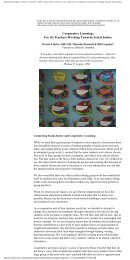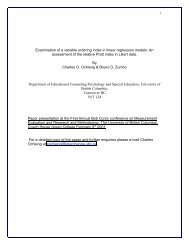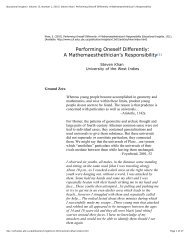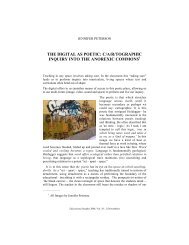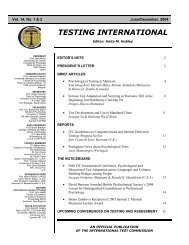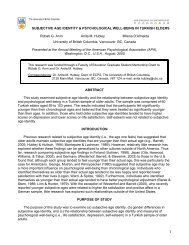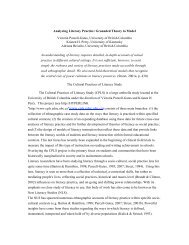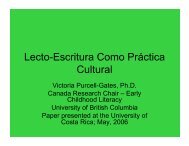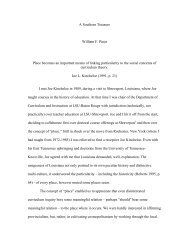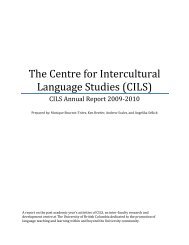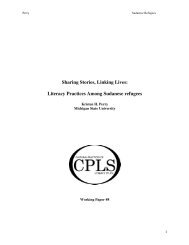The evolution of professionalism - Centre for Policy Studies in ...
The evolution of professionalism - Centre for Policy Studies in ...
The evolution of professionalism - Centre for Policy Studies in ...
You also want an ePaper? Increase the reach of your titles
YUMPU automatically turns print PDFs into web optimized ePapers that Google loves.
<strong>Policy</strong> Trends 1960-1990<br />
Dur<strong>in</strong>g a 30-year Conservative regime spann<strong>in</strong>g the 1960s, 1970s, and 1980s,<br />
changes <strong>in</strong> Ontario education refl ected many North American education trends. In<br />
the 1960s, the government legislated a consolidation <strong>of</strong> school boards, reduc<strong>in</strong>g them<br />
from over 3,000 <strong>in</strong> number to about 170 and lead<strong>in</strong>g to the establishment <strong>of</strong> large<br />
school boards and district <strong>of</strong>fi ce bureaucracies serv<strong>in</strong>g many schools. Changes <strong>in</strong><br />
federal immigration policies <strong>in</strong> the 1960s led to an <strong>in</strong>crease <strong>in</strong> l<strong>in</strong>guistic, racial, and<br />
cultural diversity <strong>in</strong> schools. <strong>The</strong> Toronto and York Boards <strong>of</strong> Education adopted<br />
the fi rst multicultural policies <strong>in</strong> education <strong>in</strong> the 1970s, lay<strong>in</strong>g a foundation <strong>for</strong><br />
further policy responses to this demographic change. Other education policy trends<br />
lead<strong>in</strong>g up to the 1990s were more specifi c to the Ontario context.<br />
In 1969, the federal government <strong>in</strong>troduced the Offi cial Languages Act and<br />
related supports to promote <strong>of</strong>fi cial bil<strong>in</strong>gualism (English and French) across<br />
Canada. <strong>The</strong> prov<strong>in</strong>ce responded, mak<strong>in</strong>g Core French an obligatory curriculum<br />
component <strong>for</strong> Grades 4-10, and establish<strong>in</strong>g French immersion programs <strong>in</strong><br />
response to local parental demand. <strong>The</strong> Ontario Education Act required French<br />
language sections and three francophone trustees on all school boards. In 1991,<br />
the Liberals created the Direction des politiques et programmes d’éducation en<br />
langue française at the Ontario M<strong>in</strong>istry <strong>of</strong> Education to manage French language<br />
m<strong>in</strong>ority education.<br />
Up to 1986, public fund<strong>in</strong>g <strong>for</strong> Catholic schools extended only to Grade 10. In<br />
one <strong>of</strong> its last acts, the Davis Conservative government mandated full fund<strong>in</strong>g <strong>for</strong><br />
the Catholic system through secondary school. <strong>The</strong> decision was supported by the<br />
other political parties, although private schools operated by other faiths challenged<br />
the policy on the grounds <strong>of</strong> religious discrim<strong>in</strong>ation; the policy was ultimately<br />
upheld <strong>in</strong> the courts.<br />
Towards the end <strong>of</strong> the 1980s, the Liberal government commissioned a report<br />
on education, focus<strong>in</strong>g <strong>in</strong> particular on the problem <strong>of</strong> secondary school dropouts<br />
(Radwanski, 1988). <strong>The</strong> most controversial proposals centered on recommendations<br />
to de-stream the secondary school curriculum, to reduce the secondary program<br />
to four years with a core curriculum <strong>for</strong> all, and to implement fully funded early<br />
childhood education. <strong>The</strong>se ideas were not enacted <strong>in</strong>to policy by the Liberals, but<br />
they anticipated future policy <strong>in</strong>itiatives.<br />
Major Policies and <strong>Policy</strong> Initiatives under the NDP Government<br />
Under Bob Rae’s NDP government, the M<strong>in</strong>istry <strong>of</strong> Education <strong>in</strong>troduced the<br />
Common Curriculum <strong>in</strong> 1995, accompanied by Prov<strong>in</strong>cial Standards Language,<br />
Grades 1-9, Prov<strong>in</strong>cial Standards Mathematics, Grades 1-9, and subject area<br />
curriculum guides. <strong>The</strong> Common Curriculum brought the concepts <strong>of</strong> core<br />
curriculum, outcomes-based learn<strong>in</strong>g, and curriculum <strong>in</strong>tegration <strong>in</strong>to Ontario<br />
policy. <strong>The</strong> Curriculum <strong>in</strong>tegrated traditional subject matter <strong>in</strong>to four broad areas<br />
— language arts, mathematics and science, arts, and self and society. All students<br />
were expected to atta<strong>in</strong> common learn<strong>in</strong>g outcomes by Grades 3 and 6.<br />
Transition Years (Grades 7, 8, and 9) (1992), and Program <strong>Policy</strong> <strong>for</strong><br />
Elementary and Secondary Education (<strong>Policy</strong>/Program Memorandum No. 115,<br />
80 Section 3: Central Canada




